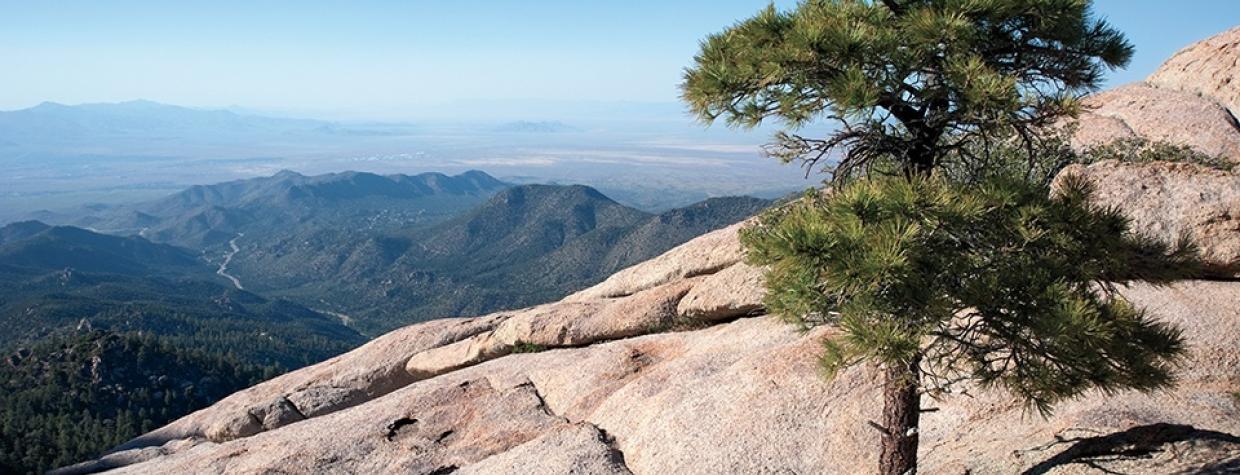Hualapai Mountain Park, Kingman
Even if your idea of heading into the backcountry is going from Park Avenue to Central Park, you can handle this trail. It’s not as easy as walking down the sidewalk, but in terms of “roughing it,” this is about as benign as it gets.
Although this hike is listed as the Aspen Peak Trail, it’s really a combination of three trails: Aspen Springs, Potato Patch Loop and Aspen Peak. To get to the trail that takes you to the top, you’ll first have to navigate the other two. But that’s not a hardship. Overall, the three trails pass through four different life zones: chaparral, pine/oak, mixed conifer and fir/aspen.
The trek begins with the Aspen Springs Trail in Sawmill Canyon, a lush riparian area of Arizona walnuts, canyon maples and various species of oaks. The climb is gradual, with mild switchbacks and a wide path that accommodates horses. A few minutes into the hike, you’ll notice a significant depression in the hillside above. This is a remnant of the old Silver Bell Mine, which first was worked by prospectors in the 1870s and eventually shut down in 1994. Just beyond the mine is a spot known as the Kingman Overlook, from which you can see the city below and the distant Cerbat Mountains.
Along with the panoramas and the rocks and trees, you’ll notice that this trail often parallels and intersects a dirt road. Don’t be confused. The dirt road is not the trail. It’s used for horses and high-clearance vehicles. Stay on the trail, which, at this point, climbs through an open forest of ponderosa pines, New Mexican locusts and Gambel oaks. Then, as the Aspen Springs Trail approaches its intersection with the Potato Patch Loop, you’ll start seeing Douglas firs and white firs. Massive granite boulders also are among the highlights as you make your way uphill.
At the intersection of the Aspen Springs Trail and the Potato Patch Loop, turn right and follow the loop in a counterclockwise direction — the Aspen Peak Trail is still about a mile away. After 10 minutes, you’ll come to a giant evergreen lying on its side. From there, the loop continues uphill, past the Music Mountains Overlook, to a point where it joins the dirt road. The trail parallels the road for about 100 yards to its intersection with the Aspen Peak Trail, which is a short (0.6 miles) side trip that leads to the Dean Peak Overlook.
Enjoy the views, then retrace your steps back to the Potato Patch Loop. When you get there, turn left and continue in a counterclockwise direction. Within a short distance, the trail joins the dirt road again. The route gets a little tricky at this point. Look left for a large concrete-block building, and follow the road that leads to it for about 15 minutes, until it reconnects with the loop trail.
Back on the trail, you’ll notice that the vegetation has changed once again. Because this is the south side of the mountain, things are drier, which means ponderosas, Gambel oaks and manzanitas predominate. It’s prime habitat for mule deer and elk, so have your camera handy. Eventually, the Potato Patch Loop circles back to its connecting point with the Aspen Springs Trail, which takes you to the trailhead. By the time you get there, you’ll feel a little burn in your legs and your lungs, but nothing too severe. This is, after all, just a walk in the park.
Length: 5.5 miles round-trip
Difficulty: Moderate
Elevation: 6,710 to 7,919 feet
Trailhead GPS: N 35˚05.795’, W 113˚53.378’
Directions: From Kingman, go east on Interstate 40 for 6 miles to Exit 59. From there, go south on DW Ranch Road for 4.5 miles to Hualapai Mountain Road, turn left and continue 4 miles to the Hualapai Mountain Park Ranger Station. The trailhead is just off the main park road, about 0.75 miles inside the park. Ask the ranger for details.
Special Consideration: A $5 per vehicle entrance fee is required.
Vehicle Requirements: None
Dogs Allowed: Yes (on a leash)
Horses Allowed: Yes
USGS Map: Hualapai Peak
Information: Hualapai Mountain Park, 928-681-5700 or parks.mohavecounty.us/parks/hualapai-mountain-park

